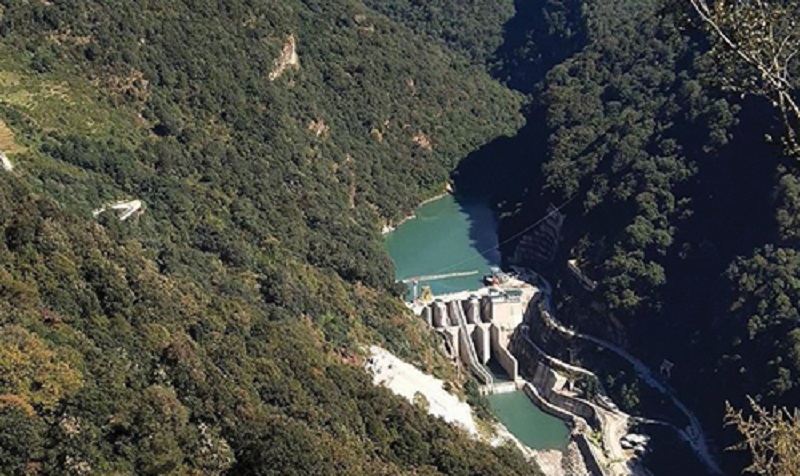His Majesty Jigme Khesar Namgyel Wangchuck, the King of Bhutan, visited Assam on April 19, 2025 to view the Inland Waterways Terminal and the Multi-Modal Logistics Park at Jogighopa.
This visit underscores the deep-rooted India-Bhutan relationship, built on shared cultural ties, strategic collaboration, and a longstanding energy partnership grounded in mutual trust and goodwill.
Hydropower: The Foundation of Cooperation
The cornerstone of India-Bhutan energy ties has been hydropower. Since the first hydropower agreement for the Jaldhaka project in 1961, numerous bilateral projects have been initiated. India has supported the development of hydropower projects in Bhutan through a mix of grants and loans and technical support relating to design and construction of the projects.
A landmark development in the history of Indo-Bhutan hydro-relations took place in 1987 with the commissioning of the 336 megawatt (MW) Chukha Hydropower Project which was fully funded by government of India. Such arrangements have been a win-win arrangement for several decades.
Bhutan currently has an installed hydropower capacity of 2,335 MW, with roughly 65% of its electricity exported to India. Hydropower contributes approximately 20% to Bhutan’s GDP and its share is roughly one-third of Bhutan’s total exports to India.
Bhutan’s estimated hydropower potential stands at 36,900 MW, with an annual generation capability of 154,000 GWh.
From Hydro Dominance to Renewable Diversification
While hydropower remains central to Bhutan’s energy and economic landscape, it presents seasonal challenges.
With several new power-intensive and IT industries proposed to be established, Bhutan’s domestic demand for energy is projected to more than double in the coming years, and its winter energy deficit will worsen.
During winter, when water flow declines, Bhutan often imports electricity—primarily coal-based—from India to meet about 10% of its needs.
In tandem with the shifting global energy landscape and to address the challenges of hydro power, Bhutan is thus diversifying to other renewables particularly solar and wind.
The government has proposed adding 1,226 MW of utility-scale solar and 23 MW of wind projects alongside the planned 12 gigawatts (GW) of hydro projects.
Bhutan’s high solar radiation and cool climate offer favourable conditions for efficient solar generation. This solar addition will help maintain energy security during lean hydro seasons and reduce fossil fuel dependence.
As per the Renewable Energy Management Master Plan (2016), Bhutan could produce 12 GW of solar and 760 MW of wind energy in technical terms.
Rooftop solar installations across homes, institutions, and businesses present further opportunities. Surplus clean energy can be exported to India and Bangladesh, enhancing Bhutan’s energy revenues and supporting regional energy security.
Additionally, Bhutan can explore green hydrogen production using hydro and solar power, providing a low-carbon fuel for transport and industry.
Expanding Private Sector Participation
An important development in Bhutan’s evolving energy strategy is its push to go beyond traditional government-to-government partnerships.
While earlier the grant to loan ratio towards capital cost to Bhutan by India was 60:40, lately, it has been changed to 30:70 resulting in challenges towards project implementation.
Government-to-government (G2G) models, although foundational, have often been hampered by bureaucratic delays. Of the four projects under the ‘10,000 MW by 2020’ agreement signed with India in 2009, only Mangdechhu (720 MW) is operational since August 2019, while others face significant delays and cost overruns.
Intergovernmental joint ventures—between public sector undertakings of both countries—have also encountered interpretational and coordination challenges.
To address this, Bhutan has introduced policies to attract private investment in energy projects. Indian companies like Tata Power (126 MW Dagachu) and Adani Group (570 MW Wangchu) have signed MoUs with Druk Green Power Corporation for hydropower development.
The Wangchu project has a lot of value as the project is likely to be converted into Bhutan’s first reservoir based project (900 MW) to significantly increase its size, importance and revenue.
These public-private partnerships offer Bhutan investment, innovation, and technical expertise, while opening new markets for Indian companies.
Indian companies can also accelerate solar deployment and integration of hybrid renewable systems, contributing to a more resilient energy landscape.
Pumped Hydro and Grid Connectivity: A Regional Opportunity
India’s growing need for clean and dispatchable electricity presents another opportunity. While solar and wind are clean, their intermittency limits their reliability.
Bhutan can play a pivotal role by developing pumped hydro storage systems, which store surplus renewable power for use during peak hours or at night.
This will not only support India’s grid but also allow Bhutan to earn premium tariffs beyond existing long-term power purchase agreements.
Bhutan’s geographic and hydropower strengths position it as a potential leader in regional energy storage.
It can also benefit from India’s “One Nation, One Grid” initiative, supplying green power directly to various Indian electricity distribution companies, subject to regulatory approvals.
This could significantly enhance Bhutan’s export capabilities and revenue.
Towards a Broader Regional Vision: BBIN and Beyond
While bilateral cooperation is robust, the future lies in regional integration.
Expanding energy collaboration under the BBIN (Bangladesh, Bhutan, India, Nepal) framework and into ASEAN via Myanmar could unlock immense benefits—economic growth, environmental sustainability, and geopolitical stability.
However, regional integration is not without challenges. Geopolitical sensitivities, especially in Bangladesh, must be navigated carefully.
A constructive approach would be to prioritize economic and energy interdependence. Cross-border electricity trade can be a catalyst for cooperation.
Allowing electricity transit rights—Bhutan to Bangladesh via India and North east India to the rest of India via Bangladesh—would be mutually beneficial.
It would diversify the energy markets, boost revenues, and enhance energy security across the region.
Joint infrastructure development and cross-border power exchanges can build a stable and interconnected South Asia, positioning energy cooperation as a driver of peace and prosperity.
Conclusion
India and Bhutan stand at the cusp of a transformative era in energy cooperation. As Bhutan diversifies its renewable energy portfolio and opens its doors to private investment, India’s growing energy needs and green transition provide a perfect match.
From hydropower and solar energy to pumped hydro storage, the opportunities are immense.
This evolving partnership is more than just about electricity — it is about sustainability, innovation, and regional collaboration.
By working together, India and Bhutan can not only secure their own energy futures but also serve as a beacon for clean energy cooperation in South Asia.
(Dr. Debajit Palit is Centre Head, Centre for Climate Change & Energy Transition at Chintan Research Foundation, New Delhi. Views are personal)















